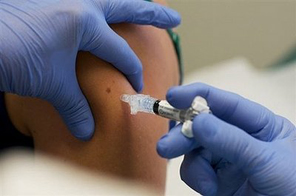Big Pharma races to get swine flu vaccines to market
PARIS: More than two dozen pharmaceutical companies are racing against the clock to test, produce and ship more than a billion doses of swine flu vaccines to anxious populations worldwide bracing for a second wave of infection.
But even if things proceed smoothly, delivery will not keep up with demand as the northern hemisphere enters the autumn and winter flu season, the World Health Organisation (WHO) has warned.
"We know that supplies will be extremely limited for some months to come," WHO chief Margaret Chan said on Friday.
Initial estimates that big pharma could crank out 94 million doses a week beginning in October have been slashed by 50 to 75 percent due to poorer than expected yields from the so-called "seed virus" strains developed by WHO-approved laboratories.
According to the global health authority, 25 drug companies have announced their intention to make the vaccines.
Five of those firms will account for more than 80 percent of production: Sanofi-Pasteur in France, AstraZeneca and GlaxoSmithKline (GSK) in Britain, Baxter in the United States, and the Swiss group Novartis.
Significant numbers of vaccines should start to arrive within five to six weeks, they say.
Baxter with orders for only 80 million doses has already finished several batches of its cell-based brand Celvapan, and said it will begin delivery while waiting for approval from national health authorities.
GSK plans to start shipments in late September, while Novartis has said it will deliver in the fall. Sanofi-Pasteur has set targets for November and December.
Never in history has there been an attempt to vaccinate so many people in so short a period of time.
Immune-boosting drugs did not even exist in 1918, when a far more virulent progenitor of the 2009 A(H1N1) virus claimed upward of 40 million lives.
And during the 20th century's other two influenza pandemics, in 1957 and 1968, vaccines arrived too late to be of much use.
The picture could improve over the coming weeks, health officials say.
If new strains under development at two WHO-partner labs New York Medical College and the National Institute of Biological Standards in Britain prove safe and more efficient, they could be slotted into the production process with only a minimal delay.
"We have indications that the yield of those newer strains is much better than the first one sent out to manufacturers," WHO spokeswoman Melinda Henry said last week, though she later told AFP that at least one has proved disappointing.
Two of the big five pharma companies, Baxter and Novartis, have applied for approval to market vaccines made from cell-based cultures, which produce far greater yields that the traditional method of growing viruses in chicken eggs.
Sinovac, a Chinese firm, announced last week that clinical trials had shown its new vaccine to be effective in single doses, potentially a major breakthrough as most experts had assumed that two doses per person would be needed.
Compounds called adjuvants that make it possible to use smaller amounts of active ingredient in each vaccine dose, already widely used in Europe, are now under consideration by the Food and Drug Administration in the United States.
But the rush to get a vaccine to market, marked by fast-track clinical trials for new strains and techniques, has prompted some experts to sound a note of caution.
They point, in particular, to an outbreak of H1N1 swine flu in 1976 at a US military base in the state of New Jersey in which 13 soldiers died. Fearing a pandemic like 1918, the government immunized more than 40 million people with a hastily-made vaccine.
"The swine flu in that case never occurred with the pathogenicity that might have been expected," said David Miller, an epidemiologist at the US National Institutes of Health.
"Instead there were cases of Guillain-Barre syndrome," a neurological disorder that causes paralysis in the legs and can lead to severe pulmonary complications, he told AFP. "It became a rather unfortunate risk-benefit equation."






